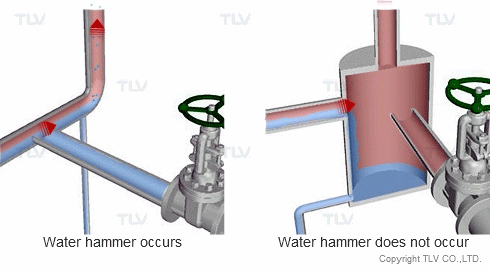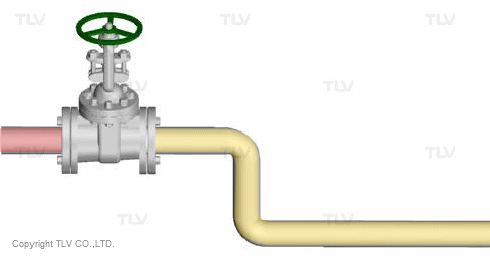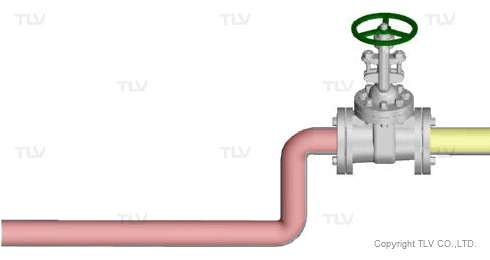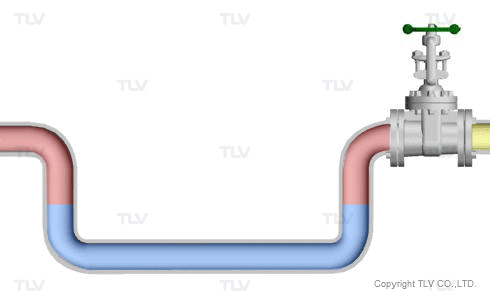- Home
- Steam Resources
- Steam Theory
- Water Hammer: Cause and Location
Steam Trap Problems
Water Hammer: Cause and Location
Water hammer can generate a large impact strong enough to instantly damage a valve, etc., or cause smaller damage over a long period of time. Whichever the case, both of these situations can lead to serious accidents, so countermeasures must be taken.
Importance of Identifying Cause and Location
When trying to prevent water hammer, determining its location and timing is important, but even more so is establishing its most likely cause.
Two pieces of advice you might hear around the workplace are: 'Close the stop valve immediately if water hammer occurs.' and 'Operate the stop valve slowly.'
Immediately closing the valve will cut off the flow of steam, and water hammer may cease. Operating the valve slowly, on the other hand, has two objectives:
- To slow the flow of steam, which weakens the force of inertia and thus weakens impacts that occur inside the piping
- To prevent the sudden generation of condensate, which limits the amount of condensate generated per unit of time
By slowly opening the stop valve, condensate cannot flow as rapidly. This might help prevent the first type of water hammer, caused by high-speed condensate crashing into piping, etc.
What if slowly operating the stop valve doesn't work?
| Water hammer stops after valve is closed |
|---|
|
|
| Water hammer continues even after valve is closed |
|---|
|
|
Water hammer that occurs even after the steam supply is cut off or when valves are operated slowly is the second type of water hammer, caused by the sudden condensation of steam.
”Waves” are what triggers this kind of water hammer. Nearby waves of condensate isolate or trap pockets of steam, and water hammer occurs. With this type of water hammer, shockwaves created by the initial impact isolate more pockets of steam and help further propagate the water hammer.
| Water hammer caused by waves |
|---|
|
|
Pockets of steam can be isolated or trapped by waves if the level of condensate inside the piping is high enough to trap or isolate pockets of steam against the walls of the piping. In experiments performed at TLV, water hammer began to occur when the level of condensate rose above approximately 80% of the interior height of the piping.
| Waves form, but low level of condensate: No water hammer |
|---|
|
|
| High level of condensate, but no waves form: No water hammer |
|---|
|
|
| Waves form and high level of condensate: Water hammer occurs |
|---|
|
|
Water Hammer in Steam Distribution Lines
Water hammer in steam distribution lines usually occurs when first supplying the steam. The previously mentioned method of operating valves slowly may help if the water hammer is caused by high-speed condensate slamming into piping, etc., but will not be effective if the water hammer is caused by the sudden condensation of steam.
As condensate is directly related to either type, properly removing condensate will lead to the most effective solution. Steam traps must be correctly installed so that the condensate inside the steam distribution lines is rapidly and completely removed.
If water hammer still occurs when proper care is given to the number and location of steam traps installed, the problem is most likely being caused by incorrect sloping of the piping. If the piping is not sloped correctly, the condensate cannot flow into the trap as planned, which can lead to high levels of condensate in unexpected locations.
In long steam distribution lines, even a slight rise in piping can result in water hammer. When installing piping using a roofline or the ground as a reference, make sure to double-check the slope of the piping.
Steam piping slopes downwards: No water hammer

Steam piping slopes upwards: Water hammer occurs

Among other possible causes of water hammer may be the accumulation of condensate where branch lines dead end. This is only a portion of the reasons why water hammer occurs. In order to truly eliminate the problem, a survey of the entire piping system should be performed to pinpoint the exact causes and plan suitable countermeasures.
Branch Piping Methods that Cause and Prevent Water Hammer








